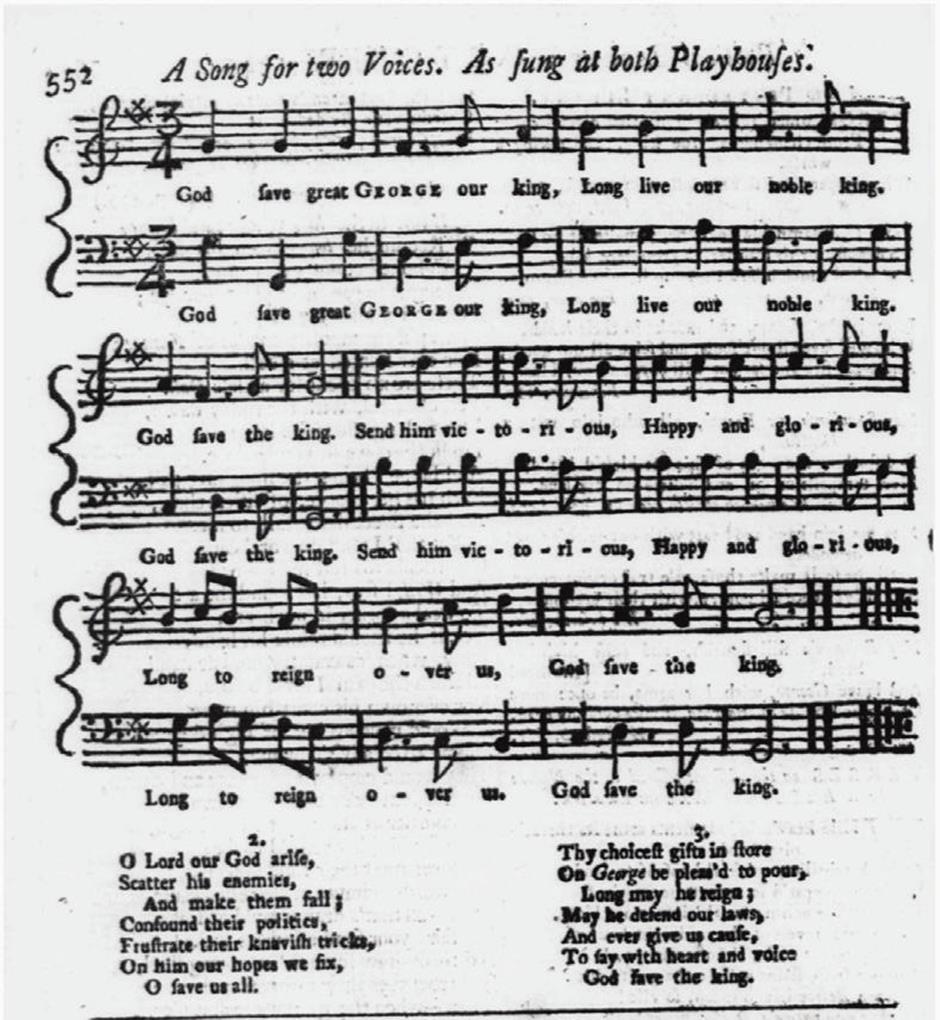
By Alison Morgan

‘A New National Anthem’ by Percy Bysshe Shelley is probably one of his least known poems. Written in 1820, in the aftermath of the Peterloo Massacre, Shelley’s poem is a paean to the female queen Liberty rather than the almost universally unpopular George IV. Shelley’s anthem is part of a tradition of radical appropriations of ‘God Save the King’ which proliferated in the 1790s, a golden age of radicalism. As the United Kingdom now faces the possible dissolution of the three hundred year old union with Scotland, it seems pertinent to consider the provenance of this song, which appears to have been written in the late seventeenth century as a Jacobite drinking song. When ‘God Save the King’ emerged in the London theatres in 1745 under a new arrangement by Thomas Arne, it was as an anti-Catholic, xenophobic song aimed at boosting English morale following a defeat by Bonny Prince Charlie. The evolution of ‘God Save the King’ from Jacobite drinking song to pillar of the British establishment to radical anthem exemplifies a dynamic relationship between literature and society in which each is shaped by the other.
In the essay ‘“God Save Our Queen!” Percy Bysshe Shelley and Radical Appropriations of the British National Anthem’ I chart the evolution of this song through radical and loyalist incarnations, thus illustrating the development of many popular ballads and songs during the eighteenth century and the ongoing battle for the ‘ownership’ of folk culture between the forces of radicalism and conservatism, a battle still being waged today through organisations such as Folk Against Fascism. In the Romantic period radicals used the national anthem to harness the immediacy and accessibility of oral popular culture in order to disseminate ancient ideals of nation and liberty. Conservative appropriations, however, were designed to celebrate and support notions of monarch and empire through the creation of Self and Other. Different versions of ‘God Save the King’ originated in Wales, Scotland, Ireland and the United States, as well as England, thereby demonstrating widespread knowledge of the song and a desire to appropriate it for mainly radical purposes.
Although many different versions of the national anthem were written during the Romantic period, the essay focusses on one of these: ‘God Save the Rights of Man’. This radical anthem, with its complicated authorship and transmission on both sides of the Atlantic, was sung by Welsh, Irish and American nationalists as a way of asserting national identities repressed by British colonialism. Similarly, English radicals sang it as a way of reclaiming an English national identity submerged under the artificial construct of Great Britain, which the ‘official’ anthem upholds, despite that fact that it is a celebration of monarchy rather than nation, which is not once mentioned. The anthems share the framing device of a specific tune, which demonstrates both their inter-relatedness and how they reflect the shifting nature of national identity during this turbulent period.

Reproduced with permission from an image produced by ProQuest LLC for its online product,
British Periodicals, 1681–1920. www.proquest.com
In common with many of the anthems of the 1790s, Shelley’s national anthem is both didactic and celebratory, aiming to give voice to the people at a time when there was increasing pressure on them to keep silent. Individually these radical anthems can be seen as advancing a specific nationalist discourse, whereas collectively they portray a unified radical identity strengthened by their commonality, resulting in texts that are simultaneously traditional and inventive. It is ironic that Shelley was appropriating a form which itself was an appropriation resulting in a cyclical process for this populist rebel song. In all of its incarnations, this song was never intended to be poetry or ‘high’ art but a collective experience in which ideals could be championed and heroes celebrated. Shelley’s contribution is undeniably a part of this tradition and contributes to the evolutionary cycle of the song. By fusing the vernacular with the literary, Shelley indicates that protest verse is not just the province of radical periodicals and ballad-writers, but can be adopted by the literary elite as he so effectively demonstrates in his other poems written in the aftermath of Peterloo.
Extract from Percy Bysshe Shelley and the British National Anthem by Alison Morgan, Romanticism 20.1, April 2014 DOI 10.3366/rom.2014.0157
Dr Alison Morgan lectures in the Romantic Period at the University of Salford. She also lectures in Education at the University of Warwick. Research interests include Percy Shelley and the poetry of the Peterloo Massacre. Recent publications include an article entitled ‘Starving Mothers and Murdered Children in Cultural Representations of Peterloo’ in Return to Peterloo published by the Manchester Centre for Regional History (2014, now The Manchester Centre for Public History and Heritage). The essay ‘”Let No Man Write My Epitaph”: The Contributions of Percy Shelley, Thomas Moore and Robert Southey to the Memorialisation of Robert Emmet’ appears in Irish Studies Review (August 2014).





